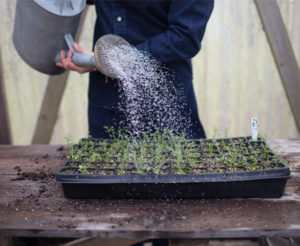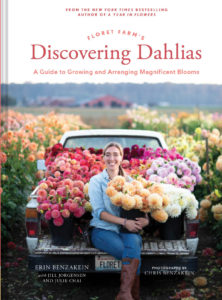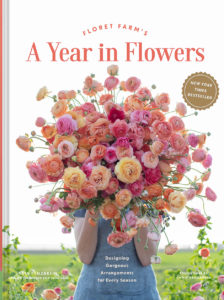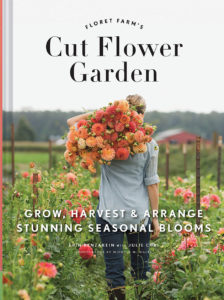Zinnias are one of the easiest cut flowers to grow. They are the perfect first crop for beginning gardeners and are reliable, prolific producers no matter where you garden.
In addition to churning out buckets and buckets of beautiful, long-stemmed blooms that are perfect for cutting, they are well-loved by pollinators.
Zinnias resent cold weather and prefer to be planted after things have warmed up a bit.
 Many gardeners in warmer parts of the world are able to successfully direct-seed zinnias straight into the garden, but here in cool Washington we start our plants early in the greenhouse, 4 to 6 weeks before our last spring frost.
Many gardeners in warmer parts of the world are able to successfully direct-seed zinnias straight into the garden, but here in cool Washington we start our plants early in the greenhouse, 4 to 6 weeks before our last spring frost.
 Plants are then tucked into the field once the weather has sufficiently warmed and all danger of frost has passed.
Plants are then tucked into the field once the weather has sufficiently warmed and all danger of frost has passed.
 Like every flower grown on our farm, we try to give them the best start possible and prepare our planting beds with a generous dose of compost and organic fertilizer. Learn more about soil preparation here.
Like every flower grown on our farm, we try to give them the best start possible and prepare our planting beds with a generous dose of compost and organic fertilizer. Learn more about soil preparation here.
 Once planting beds are prepared, we lay down drip irrigation lines and then cover the beds with a layer of preburned landscape fabric. Using fabric is not necessary for success, but here on the farm, we use it to increase heat and suppress weeds.
Once planting beds are prepared, we lay down drip irrigation lines and then cover the beds with a layer of preburned landscape fabric. Using fabric is not necessary for success, but here on the farm, we use it to increase heat and suppress weeds.
 Plants are spaced 9 to 12 in (23 to 30 cm) apart and watered deeply one to two times per week depending on the weather. If given good soil and a steady supply of water, plants can get huge and will require some type of support.
Plants are spaced 9 to 12 in (23 to 30 cm) apart and watered deeply one to two times per week depending on the weather. If given good soil and a steady supply of water, plants can get huge and will require some type of support.
 If grown in long rows, plants can be corralled by pounding heavy stakes or T-posts around the perimeter of the bed and using bailing twine to create a string-lined box to hold the plants upright. If you’re growing zinnias in your garden beds, individual plants can be tied to stakes with twine.
If grown in long rows, plants can be corralled by pounding heavy stakes or T-posts around the perimeter of the bed and using bailing twine to create a string-lined box to hold the plants upright. If you’re growing zinnias in your garden beds, individual plants can be tied to stakes with twine.
 The secret to getting the most abundant flower production and longest stems from your zinnias is pinching them when they are young. When plants are 8 to 12 in (20 to 30 cm) tall, take sharp pruners and snip the top 3 to 4 in (7 to 10 cm) off the plant, just above a set of leaves. This signals the plant to send up multiple stems from below where the cut was made.
The secret to getting the most abundant flower production and longest stems from your zinnias is pinching them when they are young. When plants are 8 to 12 in (20 to 30 cm) tall, take sharp pruners and snip the top 3 to 4 in (7 to 10 cm) off the plant, just above a set of leaves. This signals the plant to send up multiple stems from below where the cut was made.
 During spells of hot, dry weather, zinnias are prone to powdery mildew. Providing good airflow around the plants and making sure that they aren’t experiencing any drought stress will help minimize disease pressure.
During spells of hot, dry weather, zinnias are prone to powdery mildew. Providing good airflow around the plants and making sure that they aren’t experiencing any drought stress will help minimize disease pressure.
We’ve found that preventatively spraying a mixture of Cease and MilStop (both organic fungicides) every 7 to 10 days keeps it at bay.
If you’re not regularly harvesting your zinnias, be sure to deadhead any spent blooms to help focus the plant’s energy on producing new flowers and not going to seed.
 Zinnias need to be picked when they are fully ripe or they won’t last in the vase. To tell whether a zinnia is ready to harvest, use the “wiggle test.” Simply grab the stem about 8 in (20 cm) down from the flower head and gently shake it. If the stem is droopy or bends, it is not ready to cut. If the stem is stiff and remains erect, it is ready to harvest.
Zinnias need to be picked when they are fully ripe or they won’t last in the vase. To tell whether a zinnia is ready to harvest, use the “wiggle test.” Simply grab the stem about 8 in (20 cm) down from the flower head and gently shake it. If the stem is droopy or bends, it is not ready to cut. If the stem is stiff and remains erect, it is ready to harvest.
 Zinnias are considered a “dirty” flower and benefit from a drop or two of bleach in their water. Flowers are very cold sensitive, so don’t put them in the cooler. If floral preservative is added to the water, zinnias should last about a week in the vase.
Zinnias are considered a “dirty” flower and benefit from a drop or two of bleach in their water. Flowers are very cold sensitive, so don’t put them in the cooler. If floral preservative is added to the water, zinnias should last about a week in the vase.
 I’ve been growing zinnias since the very beginning, and every year I fall more and more in love with them. If you want to see all of my favorite varieties, check out the zinnia section of the Floret Library.
I’ve been growing zinnias since the very beginning, and every year I fall more and more in love with them. If you want to see all of my favorite varieties, check out the zinnia section of the Floret Library.
I would love to hear about your experience with this wonderful group of plants. Do you grow zinnias or plan to add them to your garden this coming season? If so, what are your favorite varieties, or what new treasures are you adding to your wish list?
Please note: If your comment doesn’t show up right away, sit tight; we have a spam filter that requires us to approve comments before they are published.






Jackie Patrick on
Beautiful!